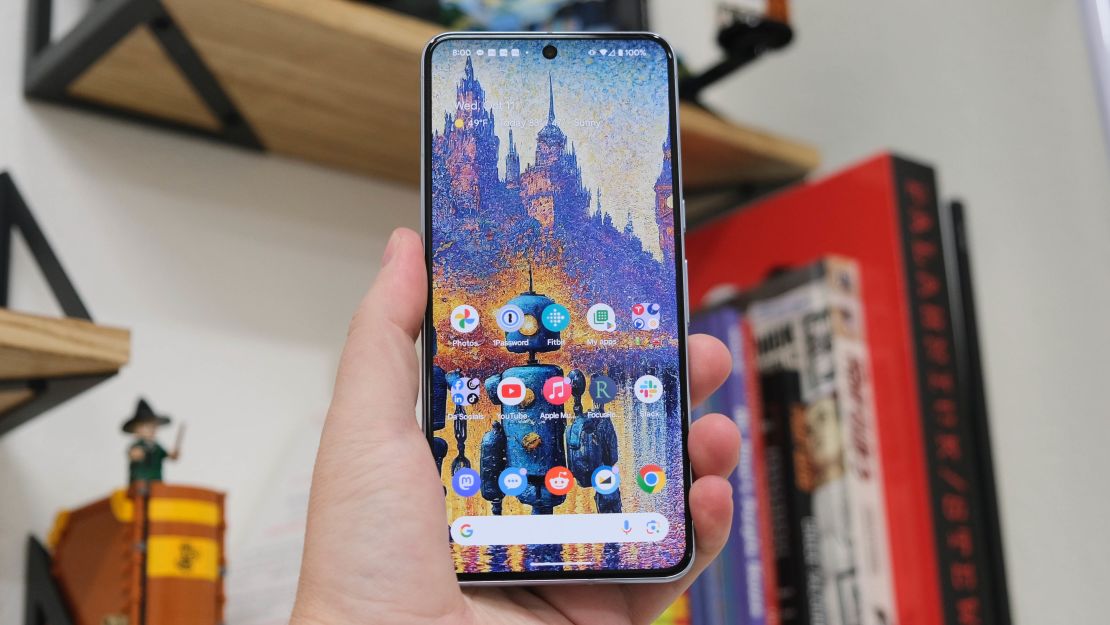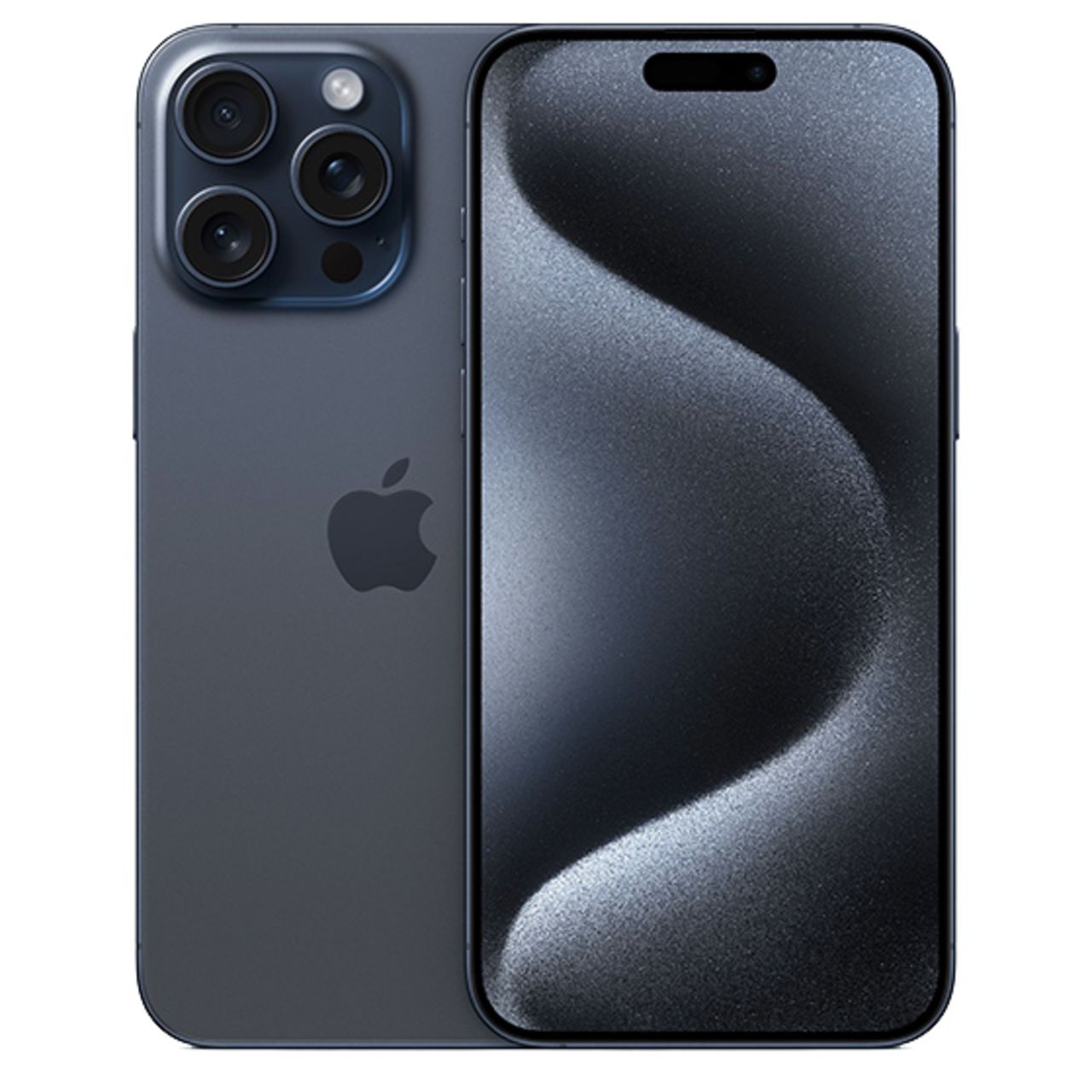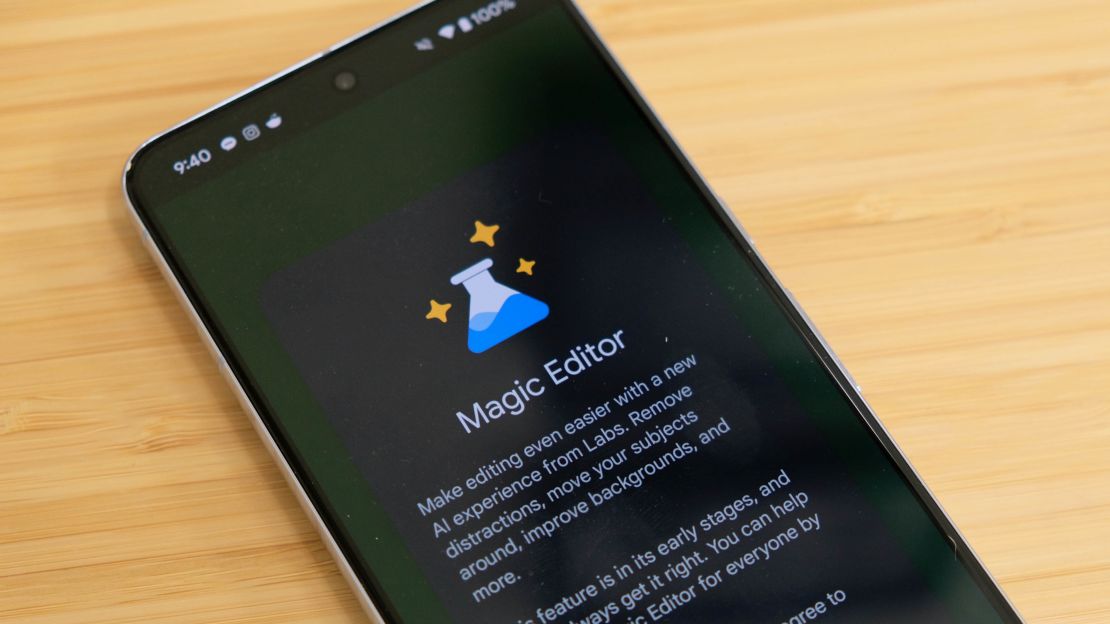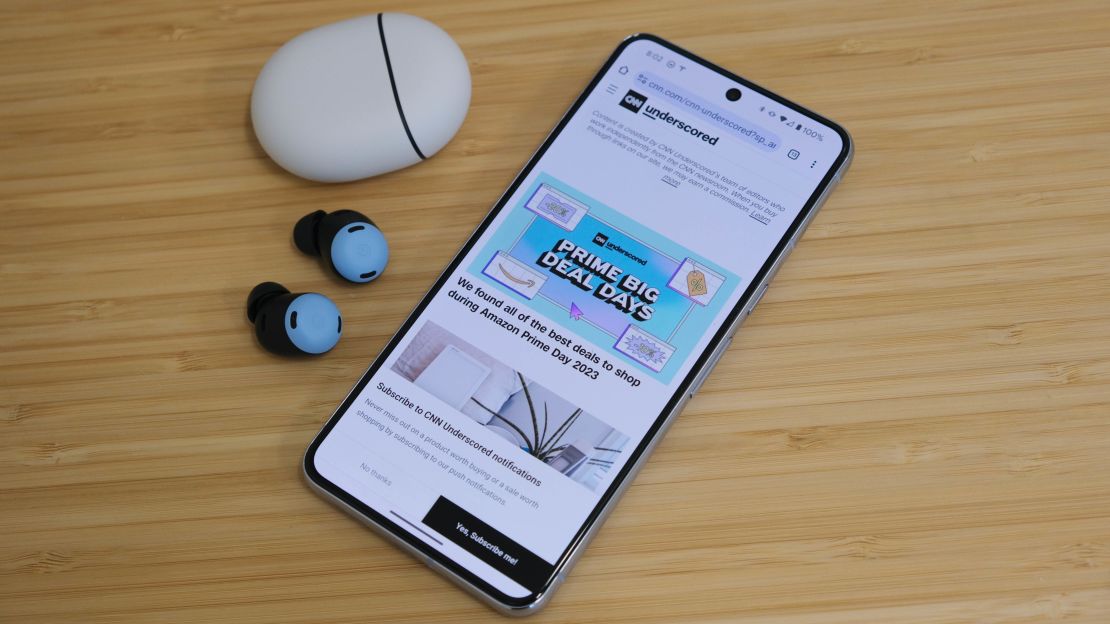Google’s Pixel 8 and Pixel 8 Pro are the company’s latest flagship smartphones and chock-full of Google’s latest AI and software features. They run Android 14 out of the box, come with seven years of software updates and leverage Google’s latest Tensor G3 processor for some pretty fancy AI features inside and outside of the camera app.
After a week of testing the Pixel 8 Pro, I have a confession to make: This is my favorite Pixel phone Google’s ever made. It’s not perfect, of course, but it’s pretty darn good — and it’s only gotten better since launch. Follow along as I count the ways.
If you’re looking for an Android phone that doesn’t come from Samsung and you want something that takes great pictures and has tons of useful software features, the Pixel 8 Pro is worth every penny of its $1,000 price tag.
What we liked about it
This design is stunning

About two hours after I unboxed the Pixel 8 Pro, it dawned on me that this is easily the best-designed Pixel I’ve ever used. The matte glass back does have a slippery feel to it, but the more rounded body in combination with the flat display on the Pro line just feels good to hold.
Prior to the 8 Pro, all of the Pixel Pro models had a curved edge display, while the standard models all had an entirely flat display. It’s the same approach Samsung has used with the S series lineup.
However, by going with an entirely flat display, Google is getting rid of a common complaint by many users of curved edge displays — accidental touches on the side of the screen. In addition to that oftentimes frustrating issue, the flat screen gives users slightly more screen space.

The Pixel 8 Pro’s screen is 6.7 inches and has a dynamic refresh rate that goes from 1 to 120Hz depending on what you’re doing. For instance, when you’re looking at a photo or reading a book, the screen will slow down to a lower refresh rate. However, when you’re doing something like scrolling or gaming, where a higher refresh rate is required, the display will match the required speed.
The total size of the 8 Pro is 6.4 by 3 by 0.3 inches and it weighs 7.5 ounces. That’s slightly smaller than the Galaxy S23 Ultra, and bigger than the iPhone 15 Pro Max. But here’s the kicker: The new rounded design, which is not near as boxy as the S23 Ultra, makes the Pixel 8 Pro feel even smaller than it really is.
On the back is Google’s now iconic camera bar, which houses three different cameras, a flash and, new to the Pixel lineup, a temperature sensor that can be used to take a temperature reading of something within a couple of inches of the back of your phone. (I have many more thoughts on this below.)

There are three color options for a Pixel 8 Pro, including a new baby blue Bay variant that’s most likely my favorite color on any phone I’ve ever used. It looks great. Obsidian and Porcelain round out the rest of the color options.
Performance isn’t an issue
Google’s third-generation Tensor processor is making its debut in the Pixel 8 Pro. Like last year’s Tensor processor, the Tensor G3 isn’t the fastest or most impressive processor when you look at benchmark scores and compare it to Qualcomm or Apple’s latest processors. Here’s a quick look at the Pixel 8 Pro’s scores compared to the iPhone 15 Pro Max, Galaxy S23 Ultra and Galaxy S24 Ultra.
|
Google Pixel 8 Pro
|

Samsung Galaxy S23 Ultra
|

Samsung Galaxy S24 Ultra
|

iPhone 15 Pro Max
|
|
|---|---|---|---|---|
| Processor | Google Tensor G3 with Titan M2 |
Snapdragon 8 Gen 2 for Galaxy |
Snapdragon 8 Gen 3 for Galaxy |
Apple A17 Pro |
| Geekbench 6 single-core | 1,707 |
2,059 |
2,211 |
2,910 |
| Geekbench 6 multi-core | 3,912 |
5,519 |
6,848 |
7,232 |
But what I think is really telling is that the Pixel 7 Pro and the G2 processor aren’t all that much slower than the 8 Pro, so Google’s newest phone might not seem like a huge performance upgrade on paper.
That said, over the last week of testing the Pixel 8 Pro, I’ve had zero issues or complaints about the overall performance of the phone. Apps launch with ease, scrolling through Reddit or Mastodon was stutter-free and playing games like Asphalt 9 proved to be a smooth and responsive experience.
As for battery life, Google promises 24 hours of battery life on the Pixel 8 Pro, and I’ve exceeded that when using the 8 Pro as my main phone over several days. I routinely went to bed with over 20% of a charge left, and that’s after a full day of testing the camera and using the phone for email, Slack and social networking.
I also ran the same battery life benchmark we run on all phones, playing a 4K video on a loop with the brightness set to 50% and recording how long it takes for the phone to turn off. The Pixel 8 Pro powered through 11 hours and 14 minutes minutes. That’s good enough to surpass the Pixel Fold and its score of 10 hours and 56 minutes, though it doesn’t quite last as long as the Samsung Galaxy Z Fold 5, with 14 hours and 47 minutes of use. It also doesn’t come close to the Galaxy S24 Ultra’s gargantuan battery life of more than 25 hours.
The moral of the story when it comes to looking at benchmarks on a phone, or any piece of tech, really, is that the benchmarks don’t tell the entire story. And it’s clear that Google isn’t setting out to impress with high benchmark Tensor scores. Instead, Google continues to improve its chip performance while also adding features like Best Take that you just know are resource intensive.
The camera impresses, once again
The cameras in the Pixel 8 Pro, on paper, are solid upgrades in their own right. But what I think is sure to attract new users to the Pixel line and spur some upgrades for Pixel owners of older models is all of the downright impressive software tools and tweaks Google is bringing to the Pixel 8 Pro’s camera and photo apps.
The Pixel 8 Pro’s camera bar on the back of the phone houses three cameras, just like last year’s Pixel 7 Pro. There’s a 50-megapixel wide camera, a 12-megapixel ultrawide camera and a 48-megapixel telephoto camera with 5x optical zoom and up to 30x digital zoom.
Google Pixel 8 Pro photos
I’ve taken a lot of shots over the last week, and these cameras are some of the best I’ve used on a Pixel phone. The main camera takes clear and crisp photos that are closer to the iPhone’s true-to-life results than I’ve seen.
The camera app is fast to load, even quicker to frame the shot and focus and easy to use without putting too many options or settings in the viewfinder.

You’ll get similar results from the remaining cameras as well, with the 5x optical zoom also producing clear photos. Even the 30x Super Res Zoom takes decent photos, but the conditions have to be ideal. For instance, the above picture of the kid statue’s face is a little grainy and not perfect, but it’s better than what I’ve seen the iPhone 15 Pro Max and Galaxy S23 Ultra do in that same scenario.
Portrait photos — even those captured on the phone’s selfie camera — also look great coming out of the Pixel 8 Pro. Again, that’s all expected coming from a Google phone, however.
Google Pixel 8 Pro portraits
More than the new hardware this year is the new software features Google is bringing to the Pixel 8 lineup. There are two main new features I’ve had a chance to test out so far. There’s Best Take, which will use multiple photos from a group photo, identify all of the faces, and then provide you with the option to change each face individually so you can piece together a shot where everyone is smiling and looking at the camera.

The other feature, Audio Magic Eraser, analyzes the audio of recorded video, and then separates it into different tracks. As you edit the video’s audio, you can lower the volume of annoying noises — like a barking dog or the wind — while leaving the music of a person’s voice alone.
Both features are neat, but they also have the tendency to get things wrong. Keep in mind, Best Take is basically automating someone Photoshopping your face from a different photo and then placing it perfectly into the picture you’re looking at. And doing this for how many ever people are in the picture, in real time, all in the Google Photos app.
When it gets it right, it’s astonishing and downright cool. I have, however, used it on some older group photos and have either seen not all that much difference between each face option, or because the camera or person moved and slightly changed the angle, the background around the head gets messed up and it doesn’t look right.
Face Unlock for every app is amazing
Last year, with the Pixel 7 and Pixel 7 Pro, Google launched a new Face Unlock feature that you could use to unlock the Pixel phone itself, but that was it. Meanwhile, Apple’s Face ID feature not only unlocks the iPhone, but can also be used to sign you into apps or services.
With the Pixel 8 and 8 Pro, however, Face Unlock now works anywhere you’d normally see a fingerprint prompt or passcode? — both of which, by the way, are also present on the Pixel 8 Pro.
I had all but forgotten about the expansion of Face Unlock after the event. However the first time I opened my password manager app after setting it up, I was immediately greeted with a screen that showed the phone scanning my face and quickly unlocking afterward. It worked just as easily and seamlessly as Apple’s Face ID.
It’s a seemingly small change to how the Face Unlock feature works, but it’s one that has a huge impact on your daily usage of the Pixel 8 Pro, especially if you have a lot of apps that leverage Face Unlock to sign in. Not to mention, the simple task of picking up your phone and having it unlock and show your home screen without you doing a thing is just a beautiful thing.
Circle to Search is a welcome addition — and new features keep arriving
The Pixel 8 Pro was already chock-full of AI features when it first launched, but it gained a pretty notable one in early 2024 in the form of Circle to Search. This handy tool is exactly what it sounds like — simply hold the home button down, draw a circle around anything on your phone’s screen and your Pixel will instantly perform a Google image search for whatever you highlighted.
This feature is useful for, say, looking up a cool dress you saw on TikTok or finding the location of a really yummy-looking ramen dish on your Instagram feed. We found it to work quickly and accurately when we first tested it on the Galaxy S24, and certainly more practical than some of the other AI features that are rapidly hitting phones right now.
Speaking of AI features, the Pixel 8 Pro is one of several devices that can now tap into Gemini, the company’s new AI helper that essentially aims to be a supercharged Google Assistant. Thanks to Gemini Nano — a version of the tech that can run on-device — the Pixel 8 Pro can automatically summarize and transcribe any voice recordings you’ve captured, which is something us reporters certainly appreciate.
While Magic Compose (which suggests alternate ways to write out a text message if you want to be extra playful or super professional) is available on the Pixel 6 and up, the Pixel 8 can run it locally, meaning you don’t need an internet connection in order to use it. While we consider Magic Compose to be one of the more gimmicky AI features out there, the fact that Pixel 8 Pro can run this kind of tech on-device means that it’ll be a bit more capable than its cheaper sibling for those interested in using AI to make everyday tasks a little easier.
What we didn’t like about it
The temperature sensor is cool, but gimmicky
The Pixel 8 Pro’s circular temperature sensor is found on the camera bar, just below the flash on the rear of the phone. To use it, you need to launch the 8 Pro’s Thermometer app on your phone. If it’s not present on your Pixel 8 Pro yet, make sure you update all of your apps in the Play Store after setting it up.
In the app, you’re asked to select the type or material of whatever object you’re trying to take a temperature reading of. There are 11 different options right now, some of which include cast iron, ceramic and glass, wood, fabric, food and organic, and default.
Once you’ve selected the proper category, you’re instructed to hold the sensor on the back of the phone about two inches away from the object, then tap the measure button on the phone’s screen. Almost immediately you’re given a temperature reading.
It’s cool, but also … why? Outside of something to mess around with just because you have it on your phone, I can’t think of any time I’ve ever wished my phone could take a temperature reading on demand. It just doesn’t make any sense to me.
Unless! Google originally added the sensor to the 8 Pro so users could take their own temperature holding it in front of their forehead, but Google didn’t have all of the proper clearances needed to release the feature to the public.
Google has said that it plans to add this functionality to the app once the FDA has approved the sensor, which would then store any of your body temperature recordings in the Fitbit app.
My current theory is that this feature was strictly a health-motivated feature, but due to a delay in getting the FDA’s approval, Google had to give users more options and categories to record temperatures.
I just don’t get it. Nor do I really want this on a phone.
Android 14 is a fun update, but…
The Pixel 8 and Pixel 8 Pro will receive security, feature drop and major OS updates for the next seven years. That means Google will stop releasing software updates and supporting the Pixel 8 line in 2030. That’s unheard of for Android devices.
Although I’m not sure how many people are going to have their Pixel 8 in 2030, it does send a message to potential customers that Google is serious about its Pixel hardware. This announcement should technically be in the what we liked about it section above, but I’ve included it here because I do have a complaint about Android 14 and the feature drops that are supposed to bring more features to the Pixel 8 Pro over the next few months.
More specifically, I’m frustrated by the rollout of said features. Instead of launching a feature drop for the Pixel and everyone gaining access at the same time, Google continues to roll out the update, slowly adding more users until everyone gains the new feature.
I sure do wish that everyone who owns a Pixel 8 Pro would get the same features at the same time. Instead, when post-launch features arrive — like Video Boost or the more recent Circle to Search tool — I’m going to be at Google’s random mercy for when my device will receive it. And that’s frustrating.
The 30W charging speed
One of my biggest annoyances with the Pixel 8 Pro is its 30W charging speed. Most of the time, the charging speed of a phone isn’t an issue, since charging overnight is my norm. However, when I’m traveling or after a long day of testing and using a phone, being able to top the phone off as quickly as possible is a huge selling point to me.
To be clear, I have the same complaint about Apple’s iPhone 15 Pro Max, which also maxes out at 30W charging. Samsung’s Galaxy S23 Ultra and S24 Ultra charge at 45W which results in less time waiting for the phone to juice up.
How it compares
| Display | 6.7-inch, 2992 x 1344 always-on Super Actua display (1 to 120Hz) |
6.8-in. Dynamic AMOLED 2X Quad HD display (1 to 120Hz) |
6.8-inch Dynamic AMOLED 2X Quad HD display at 120Hz |
6.7-inch 2796 x 1290 Super Retina XDR display |
|---|---|---|---|---|
| Processor | Google Tensor G3 with Titan M2 |
Snapdragon 8 Gen 3 for Galaxy |
Snapdragon 8 Gen 2 for Galaxy |
Apple A17 Pro |
| Storage | 128GB /256GB / 512GB / 1TB |
256GB / 512GB / 1TB |
256GB / 512GB / 1TB |
256GB / 512GB / 1TB |
| Memory | 12GB |
12GB |
12GB |
8GB |
| Camera | 50MP Octa PD wide camera, 12MP Quad PD ultrawide camera, 48MP Quad PD telephoto camera |
200MP wide camera, 50MP telephoto camera with 5x optical zoom, 12MP ultrawide camera, 10MP telephoto camera with 3x zoom |
200MP wide camera, 12MP ultrawide camera, dual 10MP telephoto cameras with 100x Space Zoom |
48MP main camera, 12MP ultrawide, 12-megapixel 5x telephoto with 25x digital zoom |
| Size and weight | 6.4 x 3.0 x 0.3 in., 7.5 oz. |
6.40 x 3.11 x 0.34 in., 8.22 oz. |
6.43 x 3.07 x 0.35 in., 8.25 oz. |
6.29 x 3.02 x 0.32 in., 7.81 oz. |
| Colors | Bay, Obsidian, Porcelain |
Titanium Black, Titanium Gray, Titanium Violet,?Titanium Yellow |
Phantom Black, Lavender, Cream and Green (everywhere); Lime, Sky Blue, Graphite and Red (Samsung exclusive) |
Black, White, Blue, Natural Titanium |
| Operating system | Android 14 |
Android 14 |
Android 14 |
iOS 17 |
| Price | $999 | $1,300 | $1,200 | $1,199 |
Bottom line

Google’s Pixel line has come a long way since the first model, and while it has taken longer than many hoped or expected, the Pixel 8 Pro feels as if Google has found its hardware and software stride. The Pixel 8 Pro’s design alone is a huge leap forward for the Pixel line. But then you look at what you can do with the software to customize and improve photos, and you can’t help but get excited about what kind of phone it’ll be seven years from now. If you still own it, that is.
If you’re looking for an Android phone that doesn’t come from Samsung and you want something that takes great pictures and has tons of useful software features, the Pixel 8 Pro is worth every penny of its $1,000 price tag. However, the Galaxy S24 is still our best Android phone pick, and its higher-end Galaxy 24 Ultra counterpart is arguably the high-end king thanks to its longer battery life and stylus support. If you’re looking to save some cash, the standard Pixel 8 does much of what the 8 Pro does for less — and the excellent $499 Pixel 8a is just about the best value in smartphones right now.
































